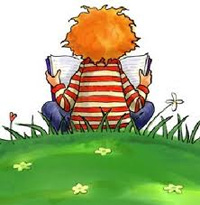 Books for children and young adults are published just about every day. Some of those titles have only limited appeal and are forgotten as soon as a reader reaches the last page. Others make readers nod their heads in recognition or inform, disturb or entertain them, possibly even prompting a guffaw or two.
Books for children and young adults are published just about every day. Some of those titles have only limited appeal and are forgotten as soon as a reader reaches the last page. Others make readers nod their heads in recognition or inform, disturb or entertain them, possibly even prompting a guffaw or two.
Then, there are those rare books that seem to necessitate a second or a third read or those trade books that stay with readers even after they’ve gone on to another book or another. These rare books that prompt slow reading and contemplation of their contents may cause us to linger with them as we digest their contents and weigh the authors’ words or grapple with issues that have been raised. In this week’s book review column, members of the International Reading Association's Children’s Literature and Reading Special Interest Group take a fond look at books that refuse to release us from their grasp.
GRADES K-2
Averback, Jim. (2013). The market bowl. Watertown, MA: Charlesbridge.
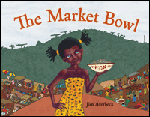 In Africa’s Cameroon, Mama Cecile is teaching young Yoyo the ways of cooking and selling their delicious bitterleaf stew at market. Mama Cecile shows Yoyo all the necessary steps to make the stew taste just right. Impatient with all the grinding and chopping, Yoyo shortcuts the directions and makes a hurry-up version of the stew. When Mama Cecile tastes Yoyo’s stew, she tells her it is only good enough for the goats and not their market customers. Yoyo refuses to listen and slips her stew into the basket for market. Mama has also cautioned Yoyo that she should always accept a fair price for the stew at risk of making Brother Coin, the Great Spirit of the Market, angry and punitive. Yoyo and Mama Cecile arrive at the market, and it is Yoyo’s first day to sit on the seller’s stool at the market. When a customer comes along and tastes Yoyo’s version of bitterleaf stew, he offers a very low price which Yoyo refuses and lets the coins fall to the ground instead of into the coin bowl. Sure enough, this action drives away customers, proving Mama is right when Brother Coin is angry. Yoyo must now think of a way to get back the blessing of Brother Coin. Illustrated with boldly colorful mixed media illustrations and a cowrie shell motif, the images add to the folklore style of this original tale of Cameroon. Readers can learn more about the back story of this Peace Corps volunteer-turned-author at his website. For interested cooks, the recipe for bitterleaf stew is included. Teachers will also enjoy the downloadable guide and activities from the publisher’s website.
In Africa’s Cameroon, Mama Cecile is teaching young Yoyo the ways of cooking and selling their delicious bitterleaf stew at market. Mama Cecile shows Yoyo all the necessary steps to make the stew taste just right. Impatient with all the grinding and chopping, Yoyo shortcuts the directions and makes a hurry-up version of the stew. When Mama Cecile tastes Yoyo’s stew, she tells her it is only good enough for the goats and not their market customers. Yoyo refuses to listen and slips her stew into the basket for market. Mama has also cautioned Yoyo that she should always accept a fair price for the stew at risk of making Brother Coin, the Great Spirit of the Market, angry and punitive. Yoyo and Mama Cecile arrive at the market, and it is Yoyo’s first day to sit on the seller’s stool at the market. When a customer comes along and tastes Yoyo’s version of bitterleaf stew, he offers a very low price which Yoyo refuses and lets the coins fall to the ground instead of into the coin bowl. Sure enough, this action drives away customers, proving Mama is right when Brother Coin is angry. Yoyo must now think of a way to get back the blessing of Brother Coin. Illustrated with boldly colorful mixed media illustrations and a cowrie shell motif, the images add to the folklore style of this original tale of Cameroon. Readers can learn more about the back story of this Peace Corps volunteer-turned-author at his website. For interested cooks, the recipe for bitterleaf stew is included. Teachers will also enjoy the downloadable guide and activities from the publisher’s website.
- Karen Hildebrand, Ohio Library and Reading Consultant
Daley, Michael J. (2013). Pinch and Dash and the terrible couch. Watertown, MA: Charlesbridge.
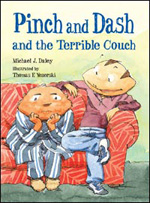 Not only are they different in their appearances, but good friends Pinch and Dash are decidedly different in their attitudes toward life. When Pinch's Aunt Hasty has a large red couch delivered to his place, he is disconcerted since it crowds the room and doesn’t match the decorating scheme. Dash arrives and helpfully tries to rearrange the furniture to make it fit, but still Pinch is unhappy because the couch overwhelms the room. After much pushing, pulling, tugging, and quite a lot of complaining from Pinch as well as lemonade break, Pinch finds the solution to his problems right next door. Readers will appreciate how the friends accept each other even while not seeing eye to eye. Both seem comfortable with their own choices and personality. The snarky attitudes of movers Push and Shove will prompt laughter, and the pen and ink and watercolor illustrations are quite appealing as well. This title is especially suited for a read aloud or a reader’s theatre adaptation.
Not only are they different in their appearances, but good friends Pinch and Dash are decidedly different in their attitudes toward life. When Pinch's Aunt Hasty has a large red couch delivered to his place, he is disconcerted since it crowds the room and doesn’t match the decorating scheme. Dash arrives and helpfully tries to rearrange the furniture to make it fit, but still Pinch is unhappy because the couch overwhelms the room. After much pushing, pulling, tugging, and quite a lot of complaining from Pinch as well as lemonade break, Pinch finds the solution to his problems right next door. Readers will appreciate how the friends accept each other even while not seeing eye to eye. Both seem comfortable with their own choices and personality. The snarky attitudes of movers Push and Shove will prompt laughter, and the pen and ink and watercolor illustrations are quite appealing as well. This title is especially suited for a read aloud or a reader’s theatre adaptation.
- Barbara A. Ward, Washington State University Pullman
Davies, Matt. (2013). Ben rides on. New York: Macmillan/Roaring Brook Press.
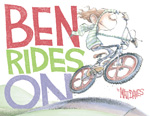 Now that third grader Ben has a great bicycle, the trip to school is nowhere near as unpleasant as it once was. He can take the scenic—longer—route to his destination. Still, once he arrives, the real reason for his dislike for school is revealed in the form of Adrian Underbite, "the world's largest third-grader" (unpaged), who immediately seizes the bike. Helpless to stop the bully, Ben spends the rest of the day fuming and plotting revenge. On his way home, though, he finds Adrian in a bad spot and has the perfect opportunity to pay him back. Nevertheless, Ben puts his anger aside and does the right thing. Naturally, he's shocked when Adrian takes off with the bike once again after he's been rescued. Is there no justice in the world? Ah, but the twist at the end makes Ben’s kind actions all worthwhile. This book prompts discussions on several topics, including bullying, standing up for yourself, and the consequences of kindness. Readers may enjoy the cartoon-like illustrations featuring Ben's facial expressions and the pathways that lead to detours from school just as much as the text.
Now that third grader Ben has a great bicycle, the trip to school is nowhere near as unpleasant as it once was. He can take the scenic—longer—route to his destination. Still, once he arrives, the real reason for his dislike for school is revealed in the form of Adrian Underbite, "the world's largest third-grader" (unpaged), who immediately seizes the bike. Helpless to stop the bully, Ben spends the rest of the day fuming and plotting revenge. On his way home, though, he finds Adrian in a bad spot and has the perfect opportunity to pay him back. Nevertheless, Ben puts his anger aside and does the right thing. Naturally, he's shocked when Adrian takes off with the bike once again after he's been rescued. Is there no justice in the world? Ah, but the twist at the end makes Ben’s kind actions all worthwhile. This book prompts discussions on several topics, including bullying, standing up for yourself, and the consequences of kindness. Readers may enjoy the cartoon-like illustrations featuring Ben's facial expressions and the pathways that lead to detours from school just as much as the text.
- Barbara A. Ward, Washington State University Pullman
Fleming, Candace. (2013). Papa’s mechanical fish. Illus. by Boris Kulikov. New York: Farrar, Straus and Giroux.
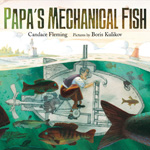 Virena's father loves to invent things, and for some reason, he becomes obsessed with the idea of a vessel that can move underwater just like a fish. After several failed attempts and revised plans, he succeeds, and the whole family gets to enjoy his invention. Not only will readers adore the fact that the story is based on Lodner Phillips, a real life inventor whose family motored through Lake Michigan in his invention, but they’ll enjoy the language used to describe this creative spirit at work ["Clink! clankety-bang! Thump-whirrrr!" (unpaged)] and the story's repetitive pattern. Each time he comes up with a new plan that he thinks will work, Papa bids goodbye to his family and sets off hopefully, only to come short. All four children make comments, and their mother always expresses relief that she happened to bring just what is needed at the time. Often drawn in panels, the illustrations include diagrams for each of Papa's underwater inventions, and are sure to fascinate readers. Back matter includes information about the story's actual inspiration.
Virena's father loves to invent things, and for some reason, he becomes obsessed with the idea of a vessel that can move underwater just like a fish. After several failed attempts and revised plans, he succeeds, and the whole family gets to enjoy his invention. Not only will readers adore the fact that the story is based on Lodner Phillips, a real life inventor whose family motored through Lake Michigan in his invention, but they’ll enjoy the language used to describe this creative spirit at work ["Clink! clankety-bang! Thump-whirrrr!" (unpaged)] and the story's repetitive pattern. Each time he comes up with a new plan that he thinks will work, Papa bids goodbye to his family and sets off hopefully, only to come short. All four children make comments, and their mother always expresses relief that she happened to bring just what is needed at the time. Often drawn in panels, the illustrations include diagrams for each of Papa's underwater inventions, and are sure to fascinate readers. Back matter includes information about the story's actual inspiration.
- Barbara A. Ward, Washington State University Pullman
Fogliano, Julie. (2013). If you want to see a whale. Illus. by Erin E. Stead. New York: Roaring Brook Press.
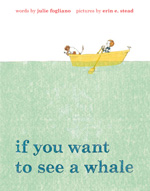 This quiet, delightful story begs to be shared with children. The words capture the spirit of the story while the illustrations take readers, and watchers, to another level of observing. From the pair that brought young readers And Then It’s Spring (Roaring Brook Press, 2012), this new picture book features a young boy and his animal friends, a basset hound and a bird, looking for whales. The young boy begins by looking out a large picture window and seeing the ocean. All kinds of things appear for him to view around the harbor, and when he spies a huge rock in the shape of a whale, he asks, “Is that a whale?” (p. 5). His imagination takes over, and he and the dog set sail in his “not-so-comfy” chair to continue his search. As his journey continues, the narrator/boy cautions that you can’t get sidetracked by stopping to look at the roses for the lovely color and smell or getting distracted by the boats with flags flapping in the wind or thinking about pirates. You can’t stop to watch the clouds take shape in the sky or notice something small inching its way through the grass. No, you must be patient and wait … and wait … and wait. The last page of the book is so worth the wait! This beautiful little book is perfect for a cozy lap story or for a group of young readers. Parents and teachers may want to use this book trailer to introduce the book or visit the illustrator’s website for a close-up look at some of the illustrations.
This quiet, delightful story begs to be shared with children. The words capture the spirit of the story while the illustrations take readers, and watchers, to another level of observing. From the pair that brought young readers And Then It’s Spring (Roaring Brook Press, 2012), this new picture book features a young boy and his animal friends, a basset hound and a bird, looking for whales. The young boy begins by looking out a large picture window and seeing the ocean. All kinds of things appear for him to view around the harbor, and when he spies a huge rock in the shape of a whale, he asks, “Is that a whale?” (p. 5). His imagination takes over, and he and the dog set sail in his “not-so-comfy” chair to continue his search. As his journey continues, the narrator/boy cautions that you can’t get sidetracked by stopping to look at the roses for the lovely color and smell or getting distracted by the boats with flags flapping in the wind or thinking about pirates. You can’t stop to watch the clouds take shape in the sky or notice something small inching its way through the grass. No, you must be patient and wait … and wait … and wait. The last page of the book is so worth the wait! This beautiful little book is perfect for a cozy lap story or for a group of young readers. Parents and teachers may want to use this book trailer to introduce the book or visit the illustrator’s website for a close-up look at some of the illustrations.
- Karen Hildebrand, Ohio Library and Reading Consultant
Geisert, Arthur. (2013). Thunderstorm. Brooklyn, New York: Enchanted Lion Books.
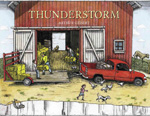 Using his signature copperplate etchings, soft watercolor illustrations and wordless format, Arthur Geisert has brought to life a Midwestern thunderstorm as he gathers the clouds and the wind to show how the storm builds and travels minute by minute over a six-hour period. Using a timeline at the bottom of each wordless page, readers will watch the storm grow into a not untypical thunderstorm that America’s heartland has witnessed time and again. Using cross-sections of homes, barns, and animal habitats, readers watch as everyone and everything prepares for the gathering storm. A family in a red pick-up truck hauling bales of hay stops to help neighbors but they are eventually caught in the midst of the storm and have to seek shelter under a bridge. The storm gathers strength and lighting, thunder, wind, and funnel clouds take shape. A flash flood rushes through and between wind and water the trees and homes in the area are picked up and thrown about the region. When the storm subsides and neighbors begin to appear from their shelters to assess the damage, they start to clean up and help each other put back the pieces of their lives. Teachers can listen to this NPR interview and backstory about the author.
Using his signature copperplate etchings, soft watercolor illustrations and wordless format, Arthur Geisert has brought to life a Midwestern thunderstorm as he gathers the clouds and the wind to show how the storm builds and travels minute by minute over a six-hour period. Using a timeline at the bottom of each wordless page, readers will watch the storm grow into a not untypical thunderstorm that America’s heartland has witnessed time and again. Using cross-sections of homes, barns, and animal habitats, readers watch as everyone and everything prepares for the gathering storm. A family in a red pick-up truck hauling bales of hay stops to help neighbors but they are eventually caught in the midst of the storm and have to seek shelter under a bridge. The storm gathers strength and lighting, thunder, wind, and funnel clouds take shape. A flash flood rushes through and between wind and water the trees and homes in the area are picked up and thrown about the region. When the storm subsides and neighbors begin to appear from their shelters to assess the damage, they start to clean up and help each other put back the pieces of their lives. Teachers can listen to this NPR interview and backstory about the author.
- Karen Hildebrand, Ohio Library and Reading Consultant
Johnston, Tony. (2013). The cat with seven names. Illus. by Christine Davenier. Watertown, MA: Charlesbridge.
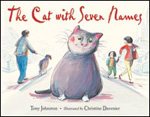 Sometimes city residents spend their days never noticing the world around them or the neighbors that could become friends. But a shared goal or interest may bring them together as this sweet story about a savvy feline reveals. As a plump gray cat wanders into the lives of six different families, each of the men, women, and a girl offer it food, give it a new name, and accept its companionship. Brought together by their concern for their furry friend when he is almost struck by a car, they all find that they have something in common despite their differences. Thanks to a cat that knew his way around the neighborhood as well as around some lonely folks' hearts, none of these neighbors will ever be lonely again. The ink and colored pencil illustrations highlight the city's busy pace and the eagerness with which all of the cat's new "owners" take him in. Although free-roaming cats on city streets may be at risk, in this case, Regis clearly uses his freedom wisely.
Sometimes city residents spend their days never noticing the world around them or the neighbors that could become friends. But a shared goal or interest may bring them together as this sweet story about a savvy feline reveals. As a plump gray cat wanders into the lives of six different families, each of the men, women, and a girl offer it food, give it a new name, and accept its companionship. Brought together by their concern for their furry friend when he is almost struck by a car, they all find that they have something in common despite their differences. Thanks to a cat that knew his way around the neighborhood as well as around some lonely folks' hearts, none of these neighbors will ever be lonely again. The ink and colored pencil illustrations highlight the city's busy pace and the eagerness with which all of the cat's new "owners" take him in. Although free-roaming cats on city streets may be at risk, in this case, Regis clearly uses his freedom wisely.
- Barbara A. Ward, Washington State University Pullman
Lunde, Stein Erik. (2012). My father’s arms are a boat. Illus. by Oyvind Torseter. Translated from the Norwegian by Kari Dickson. Brooklyn, New York: Enchanted Lion Books.
 Awarded the Norwegian Ministry’s Culture Prize for the Best Book for Children and Youth, this translated book is the first of the author’s to be published in the United States. It is also a nominee for the Hans Christian Andersen Award. Unable to sleep and grieving over the death of his mother, a young boy crawls out of bed and into the arms of his father. The two look out the window and softly discuss the foxes and the birds that are outside. When the young boy states that his grandmother told him that the red birds are dead people, their conversation immediately turns to the loss of the mother that they are both lamenting. When the young boy asks, “Is Mommy asleep? … She’ll never wake up again?” the immediate reaction of the father takes his question-riddled son outside to look at the stars. There he makes a wish, and when they go back inside to the warmth and glow of the fire, his father assures his son that everything will be all right. Cut-paper collage illustrations with black, white and blue colors offer the somber solace of quiet illustrations. This sad moment in a family’s life ends with a sigh and hope that in time, everything will, indeed, be all right.
Awarded the Norwegian Ministry’s Culture Prize for the Best Book for Children and Youth, this translated book is the first of the author’s to be published in the United States. It is also a nominee for the Hans Christian Andersen Award. Unable to sleep and grieving over the death of his mother, a young boy crawls out of bed and into the arms of his father. The two look out the window and softly discuss the foxes and the birds that are outside. When the young boy states that his grandmother told him that the red birds are dead people, their conversation immediately turns to the loss of the mother that they are both lamenting. When the young boy asks, “Is Mommy asleep? … She’ll never wake up again?” the immediate reaction of the father takes his question-riddled son outside to look at the stars. There he makes a wish, and when they go back inside to the warmth and glow of the fire, his father assures his son that everything will be all right. Cut-paper collage illustrations with black, white and blue colors offer the somber solace of quiet illustrations. This sad moment in a family’s life ends with a sigh and hope that in time, everything will, indeed, be all right.
- Karen Hildebrand, Ohio Library and Reading Consultant
Villa, Alvaro F. (2013). Flood. Mankato, MN: Picture Window Books/ Lerner.
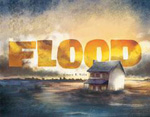 Teachers will want to pair this book with Geisert’s Thunderstorm reviewed earlier in this column to give children another wordless perspective on the effects of wild weather and storms. Argentinean artist Alvaro Villa brings the impending storm and floodwaters to life in these bold painted illustrations. As skies darken, and the father looks skyward, his family indoors is not quite yet aware of the approaching storm. Later, the family gathers around the television to hear the news about the storm, and the parents begin to worry. As the rain intensifies, workers bring a truckload of sandbags to surround and protect the house from the waters of the nearby sea. The family packs limited belongs and decides to evacuate their house. While the family presumably gets settled into a hotel, the double-page spreads that follow depict the ocean waters invading their home and flooding the lower level of the house. Furniture and tree limbs, roof shingles, and rising water wreck havoc in their home. As dawn approaches and the rays of the sun begin to come back through the clouds, the family returns to view the damage. Though badly shaken, the house still stands. In a rather quick next page, the repairs and damage control begin to find the house back to normal on the final pages. Interested readers can download the detailed readers’ guide at the publisher’s website. The publisher has partnered with Save the Children for Emergency Relief in the production of this book.
Teachers will want to pair this book with Geisert’s Thunderstorm reviewed earlier in this column to give children another wordless perspective on the effects of wild weather and storms. Argentinean artist Alvaro Villa brings the impending storm and floodwaters to life in these bold painted illustrations. As skies darken, and the father looks skyward, his family indoors is not quite yet aware of the approaching storm. Later, the family gathers around the television to hear the news about the storm, and the parents begin to worry. As the rain intensifies, workers bring a truckload of sandbags to surround and protect the house from the waters of the nearby sea. The family packs limited belongs and decides to evacuate their house. While the family presumably gets settled into a hotel, the double-page spreads that follow depict the ocean waters invading their home and flooding the lower level of the house. Furniture and tree limbs, roof shingles, and rising water wreck havoc in their home. As dawn approaches and the rays of the sun begin to come back through the clouds, the family returns to view the damage. Though badly shaken, the house still stands. In a rather quick next page, the repairs and damage control begin to find the house back to normal on the final pages. Interested readers can download the detailed readers’ guide at the publisher’s website. The publisher has partnered with Save the Children for Emergency Relief in the production of this book.
- Karen Hildebrand, Ohio Library and Reading Consultant
Willems, Mo. (2013). A big guy took my ball! New York: Disney/Hyperion.
 Beginning readers will enjoy being able to read this title on their own, since many of the words are repeated in such an engaging way. Excited and upset Piggie tells her friend Gerald all about how much fun it was to play with a big ball she found. But her fun ended too soon when some big guy took the ball away from her. Filled with wrath over the injustice of the situation and Piggy’s having been bullied and denied her innocent fun, Gerald dashes to the rescue. The steam he’s built up on behalf of his smaller friend dissipates once he sees how big the other guy is. It turns out the ball belongs to a whale that is just looking for someone with whom to play. The simple text and illustrations combine to make readers smile, especially since the bully and the ending turn out to be much different than might be expected.
Beginning readers will enjoy being able to read this title on their own, since many of the words are repeated in such an engaging way. Excited and upset Piggie tells her friend Gerald all about how much fun it was to play with a big ball she found. But her fun ended too soon when some big guy took the ball away from her. Filled with wrath over the injustice of the situation and Piggy’s having been bullied and denied her innocent fun, Gerald dashes to the rescue. The steam he’s built up on behalf of his smaller friend dissipates once he sees how big the other guy is. It turns out the ball belongs to a whale that is just looking for someone with whom to play. The simple text and illustrations combine to make readers smile, especially since the bully and the ending turn out to be much different than might be expected.
- Barbara A. Ward, Washington State University Pullman
GRADES 3-5
Castellucci, Cecil. (2013). Odd duck. Illus. by Sara Varon. New York: Macmillan/First Second.
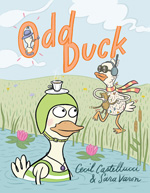 Without a doubt, the world is filled with plenty of odd ducks, and the decidedly odd Theodora goes blithely through life with no idea that others might see her as anything other than normal. So what if she swims with a teacup on her head or doesn't fly south for the winter? She's perfectly normal, after all. Upon meeting Chad, a new neighbor, at first she avoids him since he is so strange, but eventually they become friends and share many good times. But when a chance overheard remark about someone's oddness leads to an argument between the two ducks, both of them express just how odd each thinks the other one is. Angry at each other, they stalk off to their separate dwellings. But this time, being alone has lost its pleasures for Theodora and she misses her odd friend. In the end, Theodora and Chad decide that being odd is perfectly fine as long as you have a friend who is also a bit odd. Filled with cartoonish illustrations, this book contains an excellent message for youngsters about being true to oneself, but it delivers that message in an amusing way. Read more about illustrator Sara Varon on the Engage blog.
Without a doubt, the world is filled with plenty of odd ducks, and the decidedly odd Theodora goes blithely through life with no idea that others might see her as anything other than normal. So what if she swims with a teacup on her head or doesn't fly south for the winter? She's perfectly normal, after all. Upon meeting Chad, a new neighbor, at first she avoids him since he is so strange, but eventually they become friends and share many good times. But when a chance overheard remark about someone's oddness leads to an argument between the two ducks, both of them express just how odd each thinks the other one is. Angry at each other, they stalk off to their separate dwellings. But this time, being alone has lost its pleasures for Theodora and she misses her odd friend. In the end, Theodora and Chad decide that being odd is perfectly fine as long as you have a friend who is also a bit odd. Filled with cartoonish illustrations, this book contains an excellent message for youngsters about being true to oneself, but it delivers that message in an amusing way. Read more about illustrator Sara Varon on the Engage blog.
- Barbara A. Ward, Washington State University Pullman
Cyrus, Kurt. (2013). Your skeleton is showing: Rhymes of blunder from six feet under. Illus. by Crab Scrambly. New York: Disney/Hyperion.
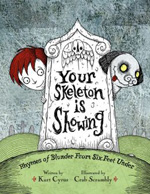 Twenty-eight amusingly gruesome poems feature a boy and a dog who wander through a graveyard in search of the dog's companion. As they walk through the fog that fills the cemetery, they listen to the stories of those buried there. Some of the tales of the inhabitants’ demise are short, only two lines in length, while others cover a couple of pages. All are sure to prompt snorts of glee from readers with a perverse sense of humor. For instance, Freddie Diggs died from picking his nose while High-Wire Pete, a high-wire acrobat, plunged to his death because he couldn't tie a knot that would hold his rope tightly. Wanda Gripp met her maker after a tight embrace from an anaconda. There's even a mysterious grave marked with the letters "EIEIO" and covered with scat and feathers. Readers will relish the word play and the cartoonish illustrations and look for more books with witty tributes to the dead such as last year’s Last Laughs: Animal Epitaphs (Charlesbridge, 2012) by J. Patrick Lewis and Jane Yolen.
Twenty-eight amusingly gruesome poems feature a boy and a dog who wander through a graveyard in search of the dog's companion. As they walk through the fog that fills the cemetery, they listen to the stories of those buried there. Some of the tales of the inhabitants’ demise are short, only two lines in length, while others cover a couple of pages. All are sure to prompt snorts of glee from readers with a perverse sense of humor. For instance, Freddie Diggs died from picking his nose while High-Wire Pete, a high-wire acrobat, plunged to his death because he couldn't tie a knot that would hold his rope tightly. Wanda Gripp met her maker after a tight embrace from an anaconda. There's even a mysterious grave marked with the letters "EIEIO" and covered with scat and feathers. Readers will relish the word play and the cartoonish illustrations and look for more books with witty tributes to the dead such as last year’s Last Laughs: Animal Epitaphs (Charlesbridge, 2012) by J. Patrick Lewis and Jane Yolen.
- Barbara A. Ward, Washington State University Pullman
Davies, Jacqueline. (2013). The candy smash. New York: Houghton Mifflin Harcourt Books for Young Readers.
 Even though Evan Treski loves his younger sister Jessie, she seems unable to respect his need for privacy or the social norms of fourth-grade life. No matter how many times he tries to explain social norms to her, she just doesn’t get them. When Valentine's candy appears unexpectedly (and anonymously) in everyone's desks, Jessie is determined to solve the mystery while also surveying everyone on their crushes. As she gathers material for the newspaper articles she plans to write, she inadvertently wounds her brother and her best friend Megan who have mutual crushes. Evan, meanwhile, is experiencing unfamiliar and confusing feelings and surprisingly finds that he secretly enjoys writing poetry. But as Jessie single-mindedly strives toward her goal, it clashes with Evan’s needs, and disaster looms. This series continues to impress with its complicated characters, interesting family dynamics, and nifty terms defined at the start of each chapter. Language arts teachers will be delighted with how Mrs. Overton, the class's teacher, shares poetry with her students, even reading her own poem written about her ailing cat Langston. The book includes appropriate-to-the-situation poems by E. E. Cummings, Sylvia Plath, Valerie Worth, Carl Sandburg, and Eleanor Farjean. How could anyone grow weary of these timeless lines or the characters in this book? Read more about author Jacqueline Davies in her "A Winning Combination" post on the Engage blog.
Even though Evan Treski loves his younger sister Jessie, she seems unable to respect his need for privacy or the social norms of fourth-grade life. No matter how many times he tries to explain social norms to her, she just doesn’t get them. When Valentine's candy appears unexpectedly (and anonymously) in everyone's desks, Jessie is determined to solve the mystery while also surveying everyone on their crushes. As she gathers material for the newspaper articles she plans to write, she inadvertently wounds her brother and her best friend Megan who have mutual crushes. Evan, meanwhile, is experiencing unfamiliar and confusing feelings and surprisingly finds that he secretly enjoys writing poetry. But as Jessie single-mindedly strives toward her goal, it clashes with Evan’s needs, and disaster looms. This series continues to impress with its complicated characters, interesting family dynamics, and nifty terms defined at the start of each chapter. Language arts teachers will be delighted with how Mrs. Overton, the class's teacher, shares poetry with her students, even reading her own poem written about her ailing cat Langston. The book includes appropriate-to-the-situation poems by E. E. Cummings, Sylvia Plath, Valerie Worth, Carl Sandburg, and Eleanor Farjean. How could anyone grow weary of these timeless lines or the characters in this book? Read more about author Jacqueline Davies in her "A Winning Combination" post on the Engage blog.
- Barbara A. Ward, Washington State University Pullman
Rhodes, Jewell Parker. (2013). Sugar. New York: Little, Brown and Company.
 Sugar is a 10-year old girl living on a sugar cane plantation in 1870 Louisiana during post Civil War Reconstruction. Her father was sold away while he was a slave, and her mother died two years ago. The community of former slaves, now sharecroppers living on the same River Road Plantation where they worked as slaves before the war, are now the ones that look after Sugar. She hates her name as it represents too many of the awful aspects of sugar cane work including the razor-sharp leaves that cut and leave scars. As more and more of the sharecropper families move north to find a life in their newly-found freedom after the Emancipation Proclamation, Sugar finds herself lonely, without young people to play with. Though she has been forbidden to play with Billy, the plantation owner’s son, the two become good friends. From Billy, Sugar learns about the new workers that are coming to the plantation to work the cane. They are Chinese immigrants, and author Jewell Parker Rhodes has brought a little-known piece of American history to light as these workers were encouraged to come to America to help with the labor shortages in the South as a result of the freed slaves. Sugar is the one to reach out to these newly arrived people and learn about their seemingly strange customs yet offer friendship and understanding. The author’s website offers numerous resources to accompany the book.
Sugar is a 10-year old girl living on a sugar cane plantation in 1870 Louisiana during post Civil War Reconstruction. Her father was sold away while he was a slave, and her mother died two years ago. The community of former slaves, now sharecroppers living on the same River Road Plantation where they worked as slaves before the war, are now the ones that look after Sugar. She hates her name as it represents too many of the awful aspects of sugar cane work including the razor-sharp leaves that cut and leave scars. As more and more of the sharecropper families move north to find a life in their newly-found freedom after the Emancipation Proclamation, Sugar finds herself lonely, without young people to play with. Though she has been forbidden to play with Billy, the plantation owner’s son, the two become good friends. From Billy, Sugar learns about the new workers that are coming to the plantation to work the cane. They are Chinese immigrants, and author Jewell Parker Rhodes has brought a little-known piece of American history to light as these workers were encouraged to come to America to help with the labor shortages in the South as a result of the freed slaves. Sugar is the one to reach out to these newly arrived people and learn about their seemingly strange customs yet offer friendship and understanding. The author’s website offers numerous resources to accompany the book.
- Karen Hildebrand, Ohio Library and Reading Consultant
GRADES 6-8
Mills, Claudia. (2013). Zero tolerance. New York: Farrar, Straus & Giroux.
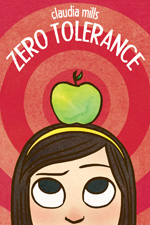 Many middle graders will be able to relate to seventh grader Sierra Shepard's plight. She's a good student, involved in school projects, with no blemish on her perfect record. But when she accidentally brings a small paring knife to school and turns it in, she faces in-school suspension and possible expulsion because she's violated her Colorado school's zero tolerance policy on weapons. While she continues to do her homework and contemplates the unfairness of her punishment, her high-power lawyer father resorts to a media blitz and possible blackmail. Some of Sierra's classmates and teachers rally around her, including school bad boy Luke Bishop with whom she bonds while they are in the suspension room. Although it's hard to like her father, especially for the way he belittles Sierra's mother, readers will feel compassion for both Sierra and her principal, Mr. Besser, who seems trapped by his own school district's discipline policies. In the end, though, this experience helps Sierra to realize that "Everything in her life was a little bit more crooked that it used to be" (p. 230). Since not all rules are ironclad, common sense needs to be applied to some of them. This book should prompt quite a bit of discussion about the wavering lines between right and wrong.
Many middle graders will be able to relate to seventh grader Sierra Shepard's plight. She's a good student, involved in school projects, with no blemish on her perfect record. But when she accidentally brings a small paring knife to school and turns it in, she faces in-school suspension and possible expulsion because she's violated her Colorado school's zero tolerance policy on weapons. While she continues to do her homework and contemplates the unfairness of her punishment, her high-power lawyer father resorts to a media blitz and possible blackmail. Some of Sierra's classmates and teachers rally around her, including school bad boy Luke Bishop with whom she bonds while they are in the suspension room. Although it's hard to like her father, especially for the way he belittles Sierra's mother, readers will feel compassion for both Sierra and her principal, Mr. Besser, who seems trapped by his own school district's discipline policies. In the end, though, this experience helps Sierra to realize that "Everything in her life was a little bit more crooked that it used to be" (p. 230). Since not all rules are ironclad, common sense needs to be applied to some of them. This book should prompt quite a bit of discussion about the wavering lines between right and wrong.
- Barbara A. Ward, Washington State University Pullman
Myers, Walter Dean. (2013). The Cruisers: Oh, snap! New York: Scholastic.
 The Cruisers, the self-named group of gifted middle graders in a Harlem school called DaVinci Academy, are at the heart of this engaging series. The issues they face are typical for middle graders, especially those that are academically advanced. All of them are quite different and have distinct opinions that they have no reluctance to express either verbally or in print. When their underground newspaper starts shaking things up at the school and it's possible that their photographer has evidence that could lead to the arrest of a classmate, the school administration puts pressure on the Cruisers to tone down their act. The author knows his characters and intended audience well and mixes in pitch-perfect dialogue and settings with humor and struggles with important matters, both on the home front and at school. As in the case of the other titles in this fast-paced series, the youngsters seem more centered than their parents do. Readers will find the envy of Zander’s mother over her former husband’s good fate quite humorous.
The Cruisers, the self-named group of gifted middle graders in a Harlem school called DaVinci Academy, are at the heart of this engaging series. The issues they face are typical for middle graders, especially those that are academically advanced. All of them are quite different and have distinct opinions that they have no reluctance to express either verbally or in print. When their underground newspaper starts shaking things up at the school and it's possible that their photographer has evidence that could lead to the arrest of a classmate, the school administration puts pressure on the Cruisers to tone down their act. The author knows his characters and intended audience well and mixes in pitch-perfect dialogue and settings with humor and struggles with important matters, both on the home front and at school. As in the case of the other titles in this fast-paced series, the youngsters seem more centered than their parents do. Readers will find the envy of Zander’s mother over her former husband’s good fate quite humorous.
- Barbara A. Ward, Washington State University Pullman
Vanderpool, Claire. (2013). Navigating early. New York: Delacorte Press.
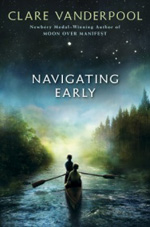 World War II has just ended, and thirteen year-old Jack Baker’s mother has recently died. Since his Navy captain father has to return to service, he places Jack in a boarding school in Maine, far from their home in Kansas. Jack has a very rough time accepting all that has happened in addition to the adjustment of boarding school. Early on at Morton Hill Academy for Boys, Jack meets another new misfit named Early Auden. Early is a savant and fascinated with numbers, especially the infinite possibilities of pi. Early is in mourning, too, as his older brother Fisher was reported dead from a battle during the war. Early convinces Jack to leave school and embark on a journey on the Appalachian Trail and the Kennebec River. Their escapade results in encounters with a great white whale, a volcano, a 100-year-old woman, pirates, caves, bears and rattlesnakes. The detailed descriptions of Maine in addition to the ways the boys work through their grief and emerging friendship is an adventure that middle readers will enjoy. Readers may want to learn more about the book at this Newbery Award winning (Moon Over Manifest, 2010) author’s website or read an interview with her on Reading Today Online’s Engage blog.
World War II has just ended, and thirteen year-old Jack Baker’s mother has recently died. Since his Navy captain father has to return to service, he places Jack in a boarding school in Maine, far from their home in Kansas. Jack has a very rough time accepting all that has happened in addition to the adjustment of boarding school. Early on at Morton Hill Academy for Boys, Jack meets another new misfit named Early Auden. Early is a savant and fascinated with numbers, especially the infinite possibilities of pi. Early is in mourning, too, as his older brother Fisher was reported dead from a battle during the war. Early convinces Jack to leave school and embark on a journey on the Appalachian Trail and the Kennebec River. Their escapade results in encounters with a great white whale, a volcano, a 100-year-old woman, pirates, caves, bears and rattlesnakes. The detailed descriptions of Maine in addition to the ways the boys work through their grief and emerging friendship is an adventure that middle readers will enjoy. Readers may want to learn more about the book at this Newbery Award winning (Moon Over Manifest, 2010) author’s website or read an interview with her on Reading Today Online’s Engage blog.
- Karen Hildebrand, Ohio Library and Reading Consultant
Vernick, Shirley Reva. (2013). Remember Dippy. El Paso, TX: Cinco Puntos Press.
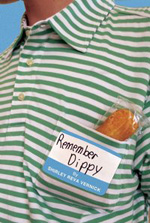 Although he doesn't like it, thirteen-year-old Johnny agrees to assist his aunt with his older cousin, Remember, during the summer while his mother is out of town. Mem has autism, which causes him to repeat phrases and misunderstand social behaviors, and Johnny finds him exceedingly strange at first. Although the summer starts with Johnny resenting and pitying his cousin, by the time it ends, he has a whole new respect perspective on Mem. There are several hilarious scenes mixed in with poignant scenes that will make readers shake their heads at how wrong we can be about others and how misguided assumptions may be. Threaded through the story are a possible romance and Johnny's pitched battle against local bully Dirk Dempster, a battle that is fought through words and letters of the alphabet posted and removed from two families’ mailboxes. Even those aspects of the story are not quite as they seem either, allowing readers to enjoy encountering the unexpected on the book’s pages and believing in the possibility of miracles in everyday matters. Clearly, heroism comes in different forms.
Although he doesn't like it, thirteen-year-old Johnny agrees to assist his aunt with his older cousin, Remember, during the summer while his mother is out of town. Mem has autism, which causes him to repeat phrases and misunderstand social behaviors, and Johnny finds him exceedingly strange at first. Although the summer starts with Johnny resenting and pitying his cousin, by the time it ends, he has a whole new respect perspective on Mem. There are several hilarious scenes mixed in with poignant scenes that will make readers shake their heads at how wrong we can be about others and how misguided assumptions may be. Threaded through the story are a possible romance and Johnny's pitched battle against local bully Dirk Dempster, a battle that is fought through words and letters of the alphabet posted and removed from two families’ mailboxes. Even those aspects of the story are not quite as they seem either, allowing readers to enjoy encountering the unexpected on the book’s pages and believing in the possibility of miracles in everyday matters. Clearly, heroism comes in different forms.
- Barbara A. Ward, Washington State University Pullman
GRADES 9-12
Crowder, Melanie. (2013). Parched. New York: Houghton Mifflin Harcourt Books for Children.
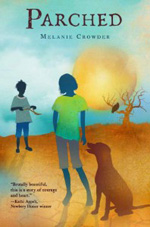 Readers may be torn between savoring this book's language or gulping water to soothe the sympathetic dryness of their throats and racing to the book's conclusion to find out what would happen to the three main characters. One of the best parts of the book is the uncertainty about whether the events are taking place somewhere in a modern setting where gangs in search of water have formed or whether it represents our own future. Instead of diamonds and oil, perhaps water will become the most important resource of all, and those who have it or know how to find it will be endangered. The story follows Sarel who draws on the knowledge about plants that her mother taught her after her parents have been killed in front of her eyes; Nandi, the loyal Rhodesian ridgeback who protects and guides Sarel; and Musa, a diviner who escapes from kidnappers in the city and then is drawn to the water he senses is somewhere in the desert. The author relies on evocative language to describe the desert's unrelenting heat and the grotto from which Sarel is desperately drawing the last drops of water. How the three form a somewhat uneasy alliance in their struggle to survive against all the odds stacked against them is fascinating. This book, the author’s debut title, will prompt much reflection and conversation and deserves a great deal of attention.
Readers may be torn between savoring this book's language or gulping water to soothe the sympathetic dryness of their throats and racing to the book's conclusion to find out what would happen to the three main characters. One of the best parts of the book is the uncertainty about whether the events are taking place somewhere in a modern setting where gangs in search of water have formed or whether it represents our own future. Instead of diamonds and oil, perhaps water will become the most important resource of all, and those who have it or know how to find it will be endangered. The story follows Sarel who draws on the knowledge about plants that her mother taught her after her parents have been killed in front of her eyes; Nandi, the loyal Rhodesian ridgeback who protects and guides Sarel; and Musa, a diviner who escapes from kidnappers in the city and then is drawn to the water he senses is somewhere in the desert. The author relies on evocative language to describe the desert's unrelenting heat and the grotto from which Sarel is desperately drawing the last drops of water. How the three form a somewhat uneasy alliance in their struggle to survive against all the odds stacked against them is fascinating. This book, the author’s debut title, will prompt much reflection and conversation and deserves a great deal of attention.
- Barbara A. Ward, Washington State University Pullman
Kindt, Matt. (2013). Red-handed: The fine art of strange crimes. New York: First Second.
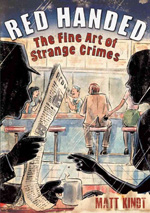 Although readers may be hard pressed to understand everything that happens or all of the connections between seemingly unrelated events and characters in this graphic novel, they will certainly enjoy it thoroughly. It’s part crime story, part philosophy lesson, part mystery, and all parts intriguing. Detective Gould is very, very good at solving crimes, but not so good at keeping his wife happy or paying attention to their relationship. As he solves crime after crime, other odd crimes, seemingly unrelated, keep cropping up. Gould is sure that he must be missing an essential clue, and it turns out that he's right. This is one of those books with so many details and layers that readers will want to reread it as soon as they finish reading it the first time. To do so will enable them to notice details such as the name of the construction company in the opening panels that might or might not significant. Second and third reads are likely to prompt reflection on the conversations about crime, justice, and art that are threaded throughout the story. This is pretty amazing stuff, guaranteed to leave readers emotionally wrung out and unsure where the line between the criminal and the law enforcer may life.
Although readers may be hard pressed to understand everything that happens or all of the connections between seemingly unrelated events and characters in this graphic novel, they will certainly enjoy it thoroughly. It’s part crime story, part philosophy lesson, part mystery, and all parts intriguing. Detective Gould is very, very good at solving crimes, but not so good at keeping his wife happy or paying attention to their relationship. As he solves crime after crime, other odd crimes, seemingly unrelated, keep cropping up. Gould is sure that he must be missing an essential clue, and it turns out that he's right. This is one of those books with so many details and layers that readers will want to reread it as soon as they finish reading it the first time. To do so will enable them to notice details such as the name of the construction company in the opening panels that might or might not significant. Second and third reads are likely to prompt reflection on the conversations about crime, justice, and art that are threaded throughout the story. This is pretty amazing stuff, guaranteed to leave readers emotionally wrung out and unsure where the line between the criminal and the law enforcer may life.
- Barbara A. Ward, Washington State University Pullman
Marchetta, Melina. (2013). Quintana of Charyn. Somerville, MA:Candlewick Press.
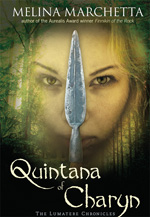 From Printz Award-winner Melina Marchetta comes the final volume of the Lumatere Chronicles trilogy (Finnikin of the Rock, 2010; Froi of the Exiles, 2012) for eager readers. Using multiple points of view, the author brings a very satisfying end to this popular fantasy series. Froi has embarked on a journey to find the pregnant princess, now Queen Quintana of Charyn, in the world of Skuldenore. The future heir of Charyn lies within her womb, and Quintana must go into hiding to protect the unborn child from those who would kill her. Froi desperately tries to find her as battle lines are drawn. Political allies and provinces are shifting allegiances. Marchetta highlights some minor characters from the series such as Tesadora, Phaedra, Peri and Lucian and expands their roles by including the stories of their backgrounds, which adds to the overall atmosphere of these tension-filled times. Froi, Finnikin and Isaboe work together to ensure Quintana’s safety. Perhaps surprisingly, a few elements of humor are sprinkled into some of the dialogue. Readers who read the first two volumes will be pleased with the conclusion of the series. Teachers may want to read more about this YA trilogy and find the study guides available at the author’s website. Read more about the author in "5 Questions With... Melina Marchetta" and about the landscape of the series in the author's post "Researching the Landscape in FROI OF THE EXILES" on the Engage blog.
From Printz Award-winner Melina Marchetta comes the final volume of the Lumatere Chronicles trilogy (Finnikin of the Rock, 2010; Froi of the Exiles, 2012) for eager readers. Using multiple points of view, the author brings a very satisfying end to this popular fantasy series. Froi has embarked on a journey to find the pregnant princess, now Queen Quintana of Charyn, in the world of Skuldenore. The future heir of Charyn lies within her womb, and Quintana must go into hiding to protect the unborn child from those who would kill her. Froi desperately tries to find her as battle lines are drawn. Political allies and provinces are shifting allegiances. Marchetta highlights some minor characters from the series such as Tesadora, Phaedra, Peri and Lucian and expands their roles by including the stories of their backgrounds, which adds to the overall atmosphere of these tension-filled times. Froi, Finnikin and Isaboe work together to ensure Quintana’s safety. Perhaps surprisingly, a few elements of humor are sprinkled into some of the dialogue. Readers who read the first two volumes will be pleased with the conclusion of the series. Teachers may want to read more about this YA trilogy and find the study guides available at the author’s website. Read more about the author in "5 Questions With... Melina Marchetta" and about the landscape of the series in the author's post "Researching the Landscape in FROI OF THE EXILES" on the Engage blog.
- Karen Hildebrand, Ohio Library and Reading Consultant
Ottaviani, Jim. (2013). Primates: The fearless science of Jane Goodall, Dian Fossey, and Birute Galdikas. Illus. by Maris Wicks. New York: Macmillan/First Second Books.
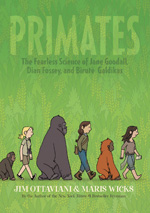 This marvelous account of the lives and life work of three extraordinary primatologists is filled with juicy details about each of them and how their lives were entwined with their mentor anthropologist Louis Leakey. The graphic novel format works well in telling the story of Jane Goodall, who studied chimps in Gombe; Dian Fossey, who studied mountain gorillas in Rwanda; and Birute Galdikas, who studied orangutans in Indonesia. Somehow it allows the life work of these women, unfettered by academic credentials when they first began their field work, to be encapsulated in short panels filled with images of the land and the animals they came to love so passionately. Readers are treated to glimpses of the women's sometimes quirky personalities and relationships with the animals they studied and with other humans and may realize the costs of their single-minded pursuit of insight into the species that fascinated each of them. This book is delightful and informative from start to finish. The fact that not every word used in the book can be verified makes little difference in providing insight into its subjects. The book’s back matter describes the research process used by the book’s creators and includes a photograph of these three amazing women.
This marvelous account of the lives and life work of three extraordinary primatologists is filled with juicy details about each of them and how their lives were entwined with their mentor anthropologist Louis Leakey. The graphic novel format works well in telling the story of Jane Goodall, who studied chimps in Gombe; Dian Fossey, who studied mountain gorillas in Rwanda; and Birute Galdikas, who studied orangutans in Indonesia. Somehow it allows the life work of these women, unfettered by academic credentials when they first began their field work, to be encapsulated in short panels filled with images of the land and the animals they came to love so passionately. Readers are treated to glimpses of the women's sometimes quirky personalities and relationships with the animals they studied and with other humans and may realize the costs of their single-minded pursuit of insight into the species that fascinated each of them. This book is delightful and informative from start to finish. The fact that not every word used in the book can be verified makes little difference in providing insight into its subjects. The book’s back matter describes the research process used by the book’s creators and includes a photograph of these three amazing women.
- Barbara A. Ward, Washington State University Pullman
Standiford, Natalie. (2013). The boy on the bridge. New York: Scholastic Press.
 Drawn by her love for Russia and her romanticized notion of its land and its peoples, college student Laura Reid spends a winter semester abroad in Leningrad in 1982. She and her classmates tolerate the brutally cold weather, the exceptionally bad food, and the ever-present suspicion of the Russians who watch them as they walk along the streets outside their dorm and classrooms. Laura's chance meeting with Alyosha on the bridge near her dorm leads to friendship and then to something else as he introduces her to the real Russia, places that only someone born in the country would know. Things move fast, and Laura starts skipping classes and staying out late in order to spend time with Alyosha. Before she knows it, they have said those three important words, and Alyosha is asking her to marry him. As her friends warn her that he may have ulterior motives for his quickly-professed love for the American girl, doubts and suspicions assail her. At some points, it's hard to tell who to trust or who to believe in this account, but the author makes it clear that desperate situations lead to desperate actions. Teen readers will be as swept up in the drama of this budding romance as Laura is, and will shiver at the ending while contemplating what Laura has lost and what she has gained.
Drawn by her love for Russia and her romanticized notion of its land and its peoples, college student Laura Reid spends a winter semester abroad in Leningrad in 1982. She and her classmates tolerate the brutally cold weather, the exceptionally bad food, and the ever-present suspicion of the Russians who watch them as they walk along the streets outside their dorm and classrooms. Laura's chance meeting with Alyosha on the bridge near her dorm leads to friendship and then to something else as he introduces her to the real Russia, places that only someone born in the country would know. Things move fast, and Laura starts skipping classes and staying out late in order to spend time with Alyosha. Before she knows it, they have said those three important words, and Alyosha is asking her to marry him. As her friends warn her that he may have ulterior motives for his quickly-professed love for the American girl, doubts and suspicions assail her. At some points, it's hard to tell who to trust or who to believe in this account, but the author makes it clear that desperate situations lead to desperate actions. Teen readers will be as swept up in the drama of this budding romance as Laura is, and will shiver at the ending while contemplating what Laura has lost and what she has gained.
- Barbara A. Ward, Washington State University Pullman
Vaughn, Lauren Roedy. (2013). OCD the dude and me: A novel. New York: Dial.
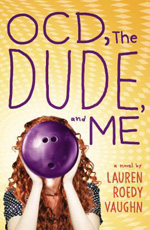 Teachers looking for YA novels that include different kinds of writing will find this book a real treasure. Written in English class essays, journal entries, and emails friendless red-head Danielle Levine tells all about herself, her weirdness (OCD), and the fact that she is alone in her little world. Her writing is often hilarious. She has OCD and is a student at a special alternative high school in California. She communicates best through her writing, which includes discussing her attraction and feelings toward the popular athlete, Jacob Kingston. Ms. Harrison, a teacher who is worried about Danielle, sends her to the school therapist who assigns her to a social skills class. It is here that she meets Daniel, a gay young man with an obsession with the movie, The Big Lebowski. As her senior year moves forward and she feels fraught with her insecurities, she makes the decision to attend the school trip and go to England where she befriends the elderly tour guides and promises to be their new Pen Pal. A prom date with Daniel, the trip to Lebowski Fest and the steps to graduation complete Danielle’s senior year with lots of bumps in the road. Along the journey, Danielle’s writing reveals her thoughts about body image, the loves of her life, her loneliness and the reasons she believes she has all these problems. With support from family, especially Aunt Joyce and Justine, readers will find a promising future for Danielle. Interested readers may learn more about this special needs teacher and debut author at her website.
Teachers looking for YA novels that include different kinds of writing will find this book a real treasure. Written in English class essays, journal entries, and emails friendless red-head Danielle Levine tells all about herself, her weirdness (OCD), and the fact that she is alone in her little world. Her writing is often hilarious. She has OCD and is a student at a special alternative high school in California. She communicates best through her writing, which includes discussing her attraction and feelings toward the popular athlete, Jacob Kingston. Ms. Harrison, a teacher who is worried about Danielle, sends her to the school therapist who assigns her to a social skills class. It is here that she meets Daniel, a gay young man with an obsession with the movie, The Big Lebowski. As her senior year moves forward and she feels fraught with her insecurities, she makes the decision to attend the school trip and go to England where she befriends the elderly tour guides and promises to be their new Pen Pal. A prom date with Daniel, the trip to Lebowski Fest and the steps to graduation complete Danielle’s senior year with lots of bumps in the road. Along the journey, Danielle’s writing reveals her thoughts about body image, the loves of her life, her loneliness and the reasons she believes she has all these problems. With support from family, especially Aunt Joyce and Justine, readers will find a promising future for Danielle. Interested readers may learn more about this special needs teacher and debut author at her website.
- Karen Hildebrand, Ohio Library and Reading Consultant
Williams, Katie. (2013). Absent. San Francisco, CA: Chronicle Books.
 Readers may be reminded of The Graveyard Book (HarperCollins, 2008) by Neil Gaiman as they sink into this title, probably because of the bond that forms between the three ghosts at the book’s heart. None of them are able to leave high school after their deaths. Paige is seventeen, and she and her fellow spirits, Evan and Brooke, spend their days watching their classmates and teachers go about their daily lives. Although they can watch, they will forever be absent from class and from the lives of those who loved them. When Paige realizes that she can possess others when they think about her, she decides to right some of the wrongs that were done to her and refute the rumor that she deliberately stepped off that school roof to her death. After all, Paige is sure that her death was an accident, and as she inhabits her best friend Usha, her secret boyfriend, the school drug dealer, her arch enemy in the school social circles, and others, she gains insight into each of them as well as herself, finding some truths that are hard to swallow. Teen readers will relish (and adopt) the terms she and Usha coined for the different cliques in their school: biblicals, burners, ponies, testos, and well-rounders, apt descriptors that typify their identities. However, as Paige comes to realize, these names describe only part of each group member's identity. Interesting and thought-provoking, this book reminds readers how complex humans are and how impossible it is to fix some things or some individuals. This book may provide good reasons to avoid those high school reunions in the future.
Readers may be reminded of The Graveyard Book (HarperCollins, 2008) by Neil Gaiman as they sink into this title, probably because of the bond that forms between the three ghosts at the book’s heart. None of them are able to leave high school after their deaths. Paige is seventeen, and she and her fellow spirits, Evan and Brooke, spend their days watching their classmates and teachers go about their daily lives. Although they can watch, they will forever be absent from class and from the lives of those who loved them. When Paige realizes that she can possess others when they think about her, she decides to right some of the wrongs that were done to her and refute the rumor that she deliberately stepped off that school roof to her death. After all, Paige is sure that her death was an accident, and as she inhabits her best friend Usha, her secret boyfriend, the school drug dealer, her arch enemy in the school social circles, and others, she gains insight into each of them as well as herself, finding some truths that are hard to swallow. Teen readers will relish (and adopt) the terms she and Usha coined for the different cliques in their school: biblicals, burners, ponies, testos, and well-rounders, apt descriptors that typify their identities. However, as Paige comes to realize, these names describe only part of each group member's identity. Interesting and thought-provoking, this book reminds readers how complex humans are and how impossible it is to fix some things or some individuals. This book may provide good reasons to avoid those high school reunions in the future.
- Barbara A. Ward, Washington State University Pullman
These reviews are submitted by members of the International Reading Association's Children's Literature and Reading Special Interest Group (CL/R SIG) and are published weekly on Reading Today Online. The International Reading Association partners with the National Council of Teachers of English and Verizon Thinkfinity to produce ReadWriteThink.org, a website devoted to providing literacy instruction and interactive resources for grades K–12.